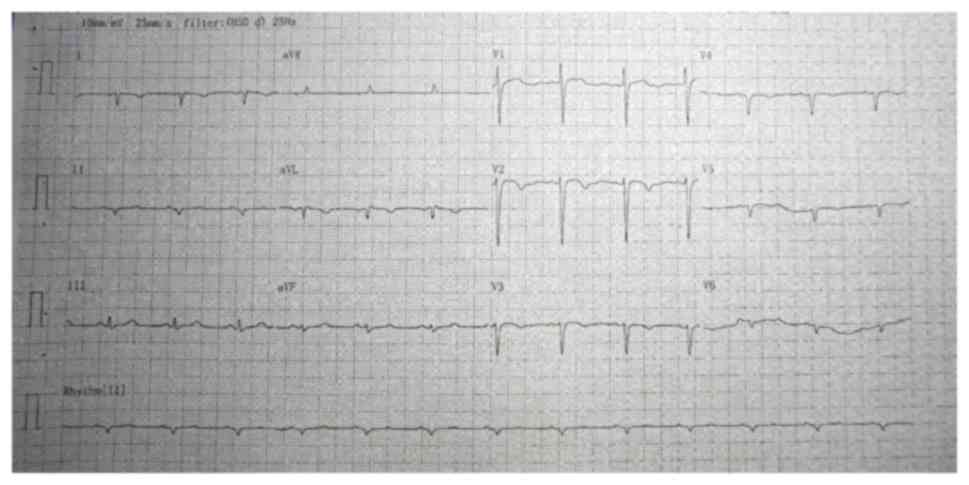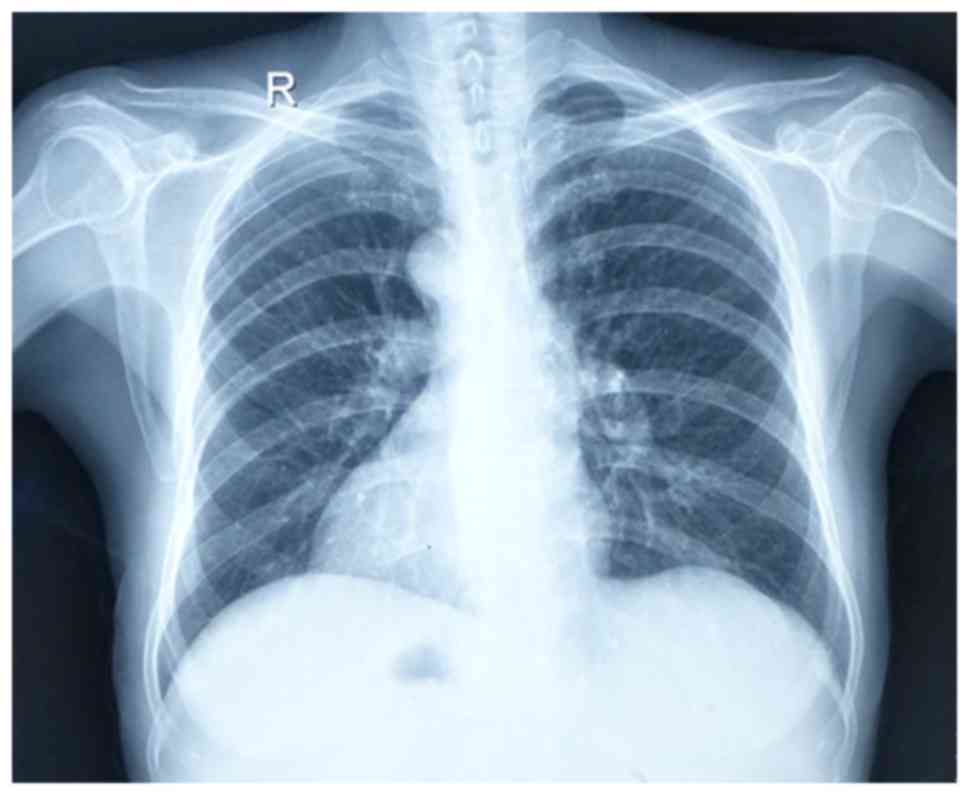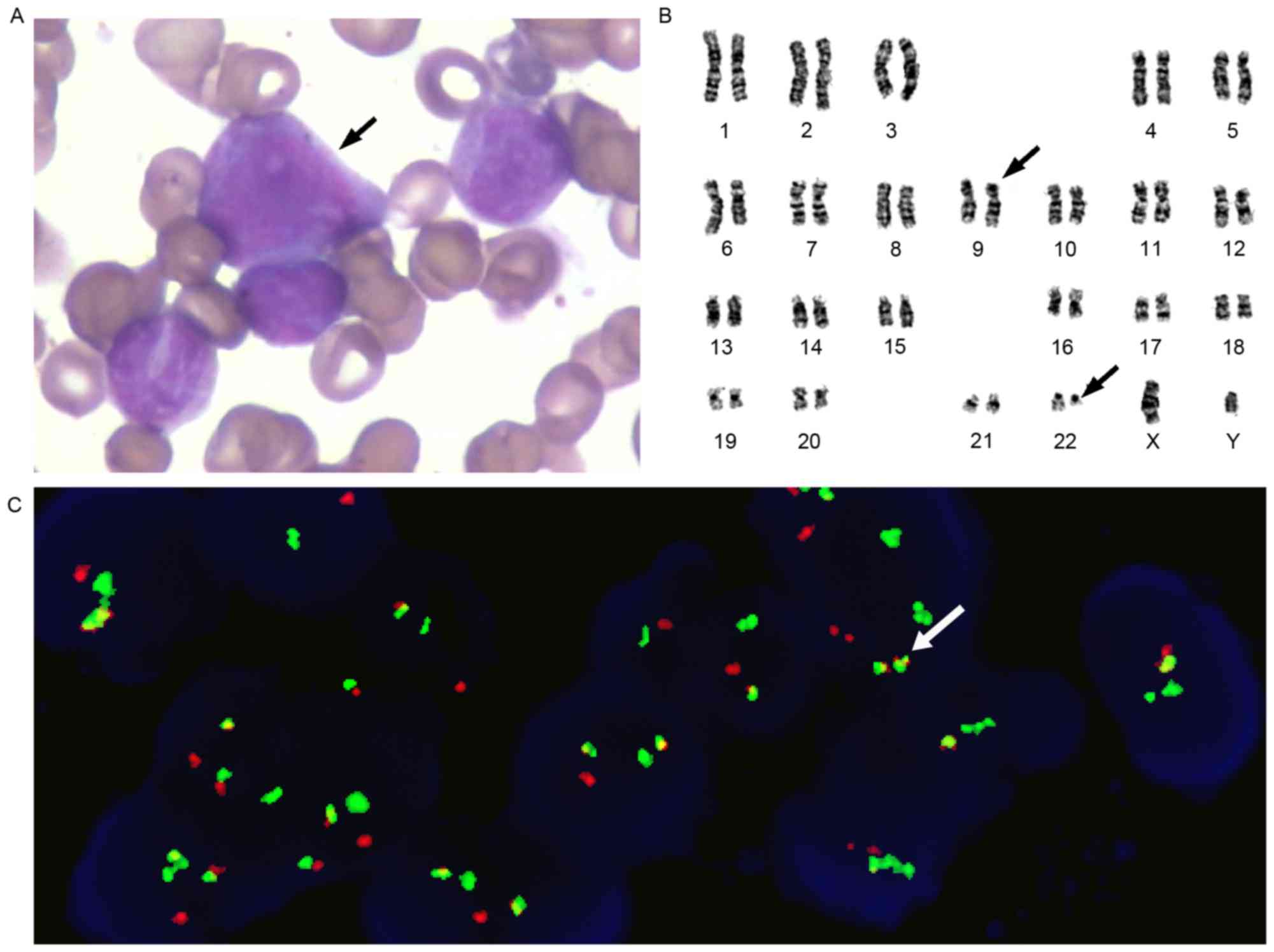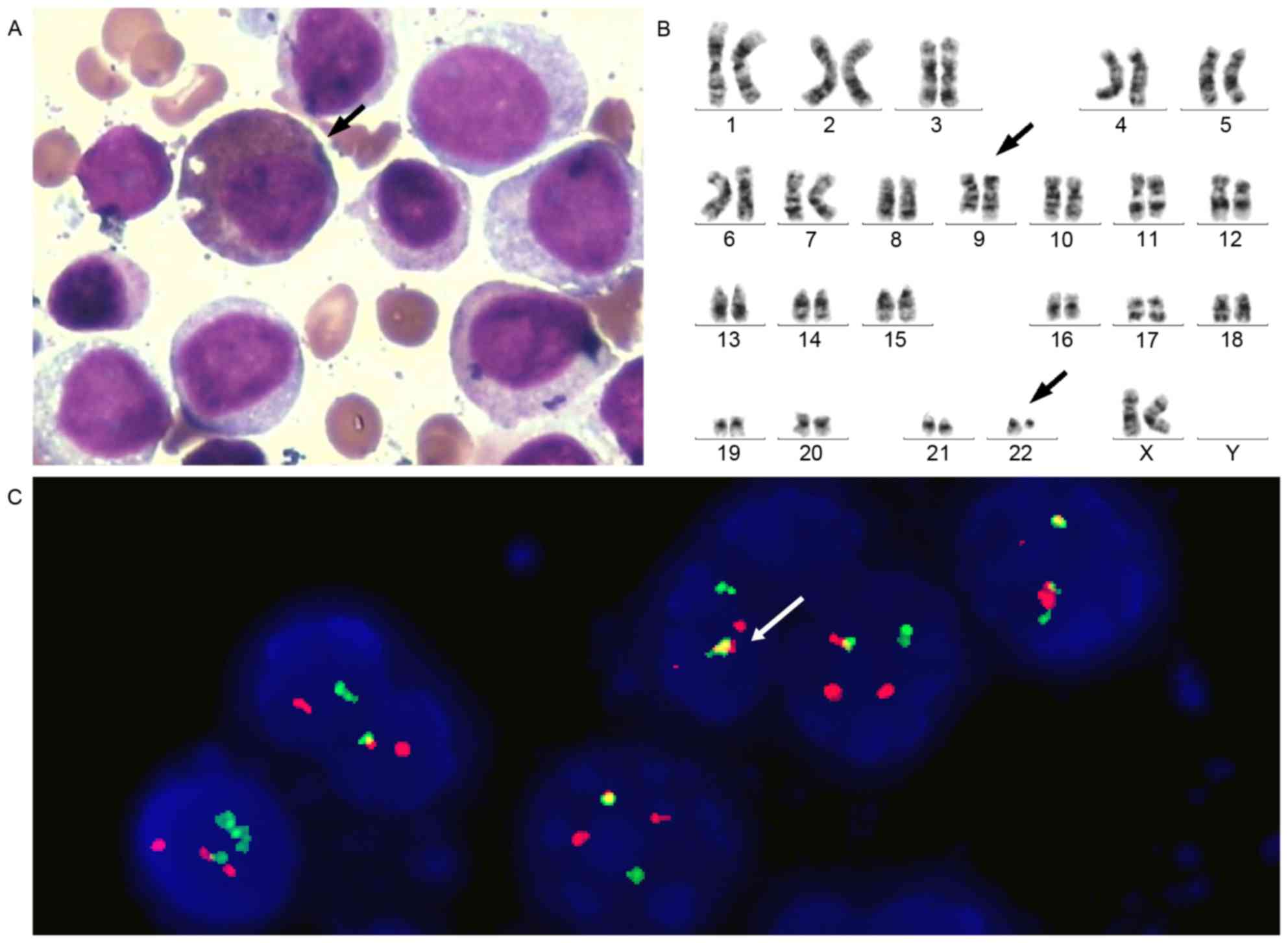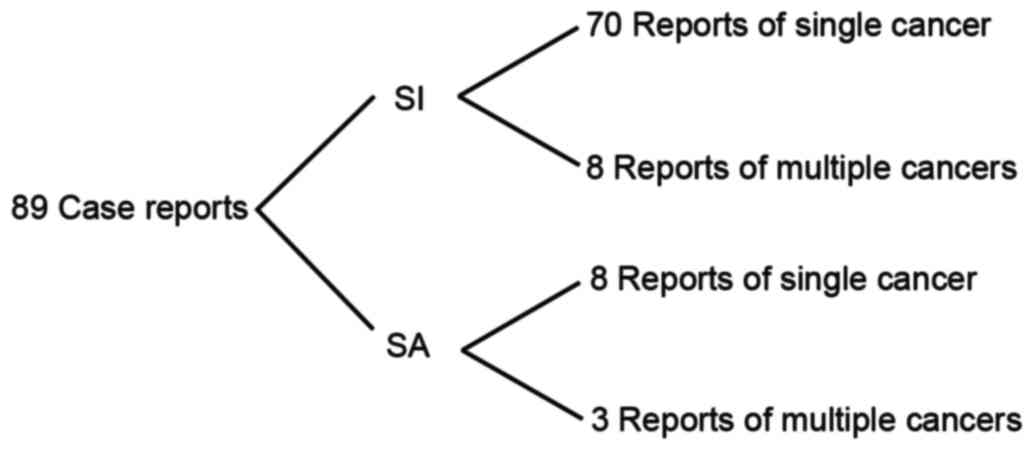A patient with chronic myeloid leukemia and situs inversus totalis: A case report
- Authors:
- Published online on: October 10, 2017 https://doi.org/10.3892/ol.2017.7166
- Pages: 7425-7430
Abstract
Introduction
Situs inversus is a rare congenital anomaly that occurred in 1/8,000-1/25,000 people globally in 2001 (1). Situs inversus totalis (SIT) is an uncommon congenital anomaly that often occurs concomitantly with other disorders (1,2), including congenital heart disease, ciliary dyskinesia, Kartagener's syndrome and polysplenia (3–5). Chronic myeloid leukemia (CML) is a malignant clonal disorder of pluripotent hematopoietic stem cells and accounts for 15% of all adult leukemia cases in the United States in 2007 (6). The diagnosis of CML is performed on the basis of detecting the breakpoint cluster region protein (BCR)-Abelson murine leukemia viral oncogene homolog 1 (ABL) gene or Philadelphia chromosome [t(9; 22)(q34; q11.2)] (7). The translocation is detected using routine cytogenetics, fluorescence in situ hybridization (FISH) and molecular reverse-transcription polymerase chain reaction tests (7). The global CML annual incidence rate was 1.6–2.0/100,000 people per year (8). The CML annual incidence rate in China was 0.36/10 million people in 1992, which was decreased compared with that in Western countries (9). The first generation of tyrosine inhibitor imatinib as a first-line treatment of patients with CML is associated with a 10-year survival rate of 85–90% (10). To the best of our knowledge, the literature reports only 1 case of CML in a patient exhibiting SIT; the patient was a 69-year-old male exhibiting chronic granulocytic leukemia and SIT, which had induced a right-sided splenomegaly that was originally diagnosed as a hepatomegaly (11). The present study reported a case of CML with complete situs inversus in a 68-year-old female patient. A series of imaging studies revealed total mirror reversal of the thoracic and abdominal organs. A bone marrow smear supported the diagnosis of CML in the accelerated phase. The co-occurrence of CML and SIT prompted the present study to evaluate whether these conditions may be associated.
Case report
A 68-year-old female patient was admitted to the Department of Hematology at The First Affiliated Hospital of Lanzhou University (Lanzhou, China) on September 3, 2012. The patient reported a 2-month history of general weakness and night sweats and a 1-month history of experiencing abdominal distension and tenderness in the right hypochondrium. A chest X-ray and conventional electrocardiogram revealed a right-sided heart. Abdominal ultrasound revealed SIT, a condition characterized by total mirrored reversal of the thoracic and abdominal organs.
A conventional electrocardiogram revealed dextrocardia (Fig. 1). A chest X-ray revealed heart and stomach gas on the right side (Fig. 2). An abdominal ultrasound examination indicated SIT and spleen enlargement. A complete blood count test obtained the following results: 12% original and naive cells (normal range, 0%); hemoglobin, 109 g/l (normal range, 110–150 g/l); 1.897×1010 leukocytes/l (normal range, 0.400–1.000×1010 leukocytes/l); 1.176×1010 neutrophils/l (normal range, 0.200–0.700×1010 neutrophils/l); 2.85×109 lymphocytes/l (normal range, 1.50–4.00×109 lymphocytes/l); 1.52×109 monocytes/l (normal range, 0.00–0.45×109 monocytes/l); 3.8×108 eosinophils/l (normal range, 0.5–3.0×108 eosinophils/l); 2.47×109 basophils/l (normal range, 0.00–0.20×109 basophils/l) and 3.86×1011 platelets/l (normal range, 1.00–3.00×1011 platelets/l). A bone marrow smear demonstrated a myeloid:erythroid ratio of 3.68:1 (normal range, 2.00–4.00:1), with original granular cells accounting for 18.0% of the total cells (normal range, 0.5–2.0%), and supported the diagnosis of CML in the accelerated phase. Karyotype analysis demonstrated 46, XX, t (9;22; q34;q11.2) in the 20 assessed cells and was the sole abnormality observed. FISH was performed using the gene locus-specific probe (GLP) BCR/GLP ABL1 to identify the BCR-ABL1 fusion gene. The rate of BCR-ABL1 fusion was 84%, as determined using FISH (Fig. 3). The present study extracted the bone marrow samples from the patients and sent the BCR-ABL1 fusion gene to undergo a quantitative polymerase chain reaction. The method was determined using fluorescence quantitative polymerase chain reaction. This method is from the bone marrow mononuclear cells in the separation and purification of RNA, TRIzol (TransStart Inc., Beijing, China) reagent was used to extract total RNA. Subsequently, reverse transcription of cDNA was performed using the reverse transcription kit (Takara Bio Inc., Otsu, Japan), using RNA as a template. The temperature protocol were as follows: 37°C for 15 min, 85°C for 5 sec and kept at 4°C until use. The fluorophore used for the polymerase chain reaction was Dalian's Tap enzyme (Takara Bio Inc.). The target gene primers were as follows: BCR-ABL, bcr: 5′-AGGGTGCACAGCCGCAACGGC-3′ and abl, 5′-GGCTTCACTCAGACCCTGAGG-3. The reference gene was β-actin. The reference gene primers were as follows: β-actin, forward: 5′-GGAGATTACTGCCCTGGCTCCTA-3′ and reverse: 5′-GACTCATCGTACTCCTGCTTGCTG-3′. The thermocycling conditions were as follows: 95°C for 30 sec for 1 cycle, 95°C for 5 sec and 60°C for 20 sec for 40 cycles. The results were expressed as 2−ΔΔCq (12). The quantity of BCR-ABL transcript was normalized to the ABL expression level. The copy number of BCR-ABL fusion gene and the copy number of ABL were calculated, and the result was expressed as the ratio of BCR-ABL copy number to ABL copy number. The present patient's BCR-ABL1 fusion gene quantitative detection revealed a BCR-ABL1 fusion gene-positive, a BCR-ABL1 copy number of 4.96×104, and a BCR-ABL1/ABL1 ratio of 5:18. Imatinib mesylate (600 mg/day) was subsequently administered from September 12, 2012 until the patient ceased taking imatinib mesylate following discharge from the hospital on September 16, 2012.
The patient last presented on November 20, 2013 with dizziness, fatigue, and abdominal distention and pain. A bone marrow smear demonstrated a myeloid:erythroid ratio of 57.33:1.00, with original granular cells accounting for 21% of the total cells, and supported the diagnosis of CML in the blast crisis phase; CML had progressed to acute myeloid leukemia (AML) M2a. Karyotype analysis also revealed 46, XX, t(9;22;q34;q11.2) in the 20 assessed cells. The positive rate of BCR-ABL1 fusion was 90%, as determined by FISH (Fig. 4).
The initial white blood cell (WBC) count was 2.495×1010/l (normal range, 4–10×1010/l). After 3 days of treatment with imatinib mesylate (600 mg/day) the WBC count of the patient had increased to 5.083×1010/l, at which point the imatinib mesylate treatment was replaced by the continuous intravenous infusion of cytarabine (200 mg/m2 day). After 2 days of cytarabine treatment, the WBC count had decreased to 1.7×1010/l and the previous relevant symptoms were no longer present. The patient was discharged from the hospital on November 28, 2013 and succumbed to AML 3 months subsequently. The patient's family provided written informed consent for the present study to be published.
Discussion
The anatomical arrangement of human organs may be described using the following categories: Situs solitus; situs inversus; and situs ambiguous. The normal position of the thoracic and abdominal viscera is referred to as situs solitus. Situs inversus is a rare congenital anomaly and is classified as either SIT or partial situs inversus (13). SIT is associated with an exchange in the position of the thoracic and abdominal viscera between the left and right sides, resulting in a mirror reversal of the thoracic and abdominal organs (14). Situs ambiguous is an uncommon condition in which the cardiac and visceral organs are abnormally distributed without mirror imaging from conventional anatomy (15).
Situs inversus is not a premalignant condition. However, rare synchronous and primary malignancies have been reported in the literature; the PubMed database includes 89 case reports of patients with cancer exhibiting situs inversus or situs ambiguous between 1952 and 2015 (Fig. 5). Among these were 78 and 11 cases of cancer in patients exhibiting situs inversus and situs ambiguous, respectively, and only 1 case of CML in a patient exhibiting SIT (11). Among these 89 case reports in the Pubmed database, the four most common cancers reported in patients with situs inversus included gastric cancer, colorectal adenocarcinoma, lung cancer and renal cell carcinoma (Table I). Information on multiple primary malignancies in patients with situs inversus or situs ambiguous (Table II), and cases of lymphoma and chronic granulocytic leukemia with situs inversus or situs ambiguous was provided (Table III).
Although the occurrence of malignancy in patients with SIT may be coincidental, certain studies have suggested a possible association between malignancy and SIT (16–18). Previous studies have proposed that unidentified genes affecting the left-right axis arrangement may be associated with cancer susceptibility (19,20). Although this may potentially explain the occurrence of cancer in the patient with SIT assessed in the present study, no genes have been conclusively identified as candidates for this dual role to the best of our knowledge (16). The pathogenetic mechanisms underlying SIT were elucidated by previous studies, and it was shown that kinesin (KIF)3, an intracellular motor protein, has an important role in establishing left-right asymmetry (17). Nodal flow is autonomously generated by the rotation of cilia tilted toward the posterior of the cells of the ventral node. KIF3 molecular motors assist in the development of these cilia but are dysfunctional in SIT (21,22). It has also been reported that the KIF3 complex is involved in neural (N)-cadherin transport to the cell surface. The cell adhesion molecules N-cadherin and β-catenin are not transported to the cell surface in patients with SIT due to the absence of function in the KIF3 complex (18). Consequently, the excess β-catenins in the cytoplasm enter the nucleus and activate genes associated with cell proliferation, thereby facilitating the development and progression of cancer in patients with SIT (17). Cell-cell adhesion assists in coordinating cellular organization and collective cell migration, and is critical for the directional looping of developing embryonic organs (23). A previous study assessed the influence of collective cell migration on the breaking of left-right symmetry, and established a 2D microscale system that may be useful for fetal drug screening to assist in identifying and potentially inhibiting birth defects associated with alterations in cell-cell adhesion (24).
Since the data in the literature indicated that the incidence of situs inversus with overall malignancy or leukemia is extremely low, the present study concluded that the occurrence of CML with SIT in the patient assessed in the present study may be by chance. However, the diagnosis of SIT may also be established by future, larger studies, which could provide a means of predicting the disease and methods to prevent its progression.
References
|
Aylsworth AS: Clinical aspects of defects in the determination of laterality. Am J Med Genet. 101:345–355. 2001. View Article : Google Scholar : PubMed/NCBI | |
|
Murakami S, Terakado M, Misumi M, Tsuji Y, Okubo K, Hirayama R, Inoue K and Arai E: Situs inversus totalis with malignant lymphoma of the stomach: Report of a case. Surg Today. 33:533–536. 2003.PubMed/NCBI | |
|
Schmutzer KJ and Linde LM: Situs inversus totalis associated with complex cardiovascular anomalies. Am Heart J. 56:761–768. 1958. View Article : Google Scholar : PubMed/NCBI | |
|
Katsuhara K, Kawamoto S, Wakabayashi T and Belsky JL: Situs inversus totalis and Kartagener's syndrome in a Japanese population. Chest. 61:56–61. 1972. View Article : Google Scholar : PubMed/NCBI | |
|
Park SS, Min BW, Kim WB, Han HJ, Yong HS, Kim SJ, Kim CS and Mok YJ: Double cancer of the stomach and oesophagus with situs ambiguus with polysplenia: The importance of preoperative evaluation. Dig Liver Dis. 37:799–802. 2005. View Article : Google Scholar : PubMed/NCBI | |
|
National Comprehensive Cancer Network: NCCN clinical practice guideline in oncology: Chronic myelogenous leukemia. V.2.2008. NCCN Web Site. 8-28-2007. https://www.nccn.org/professionals/physician_gls/f_guidelines.asp#cllJuly 26–2017 | |
|
Bennett JM, Dsouza KG, Patel M and O'Dwyer K: ‘Preleukemic or smoldering’ chronic myelogenous leukemia (CML):BCR-ABL1 positive: A brief case report. Leukemia Res Rep. 4:12–14. 2014. View Article : Google Scholar | |
|
Druker BJ and Lee SJ: Chapter 43: Chronic leukemias: Section 1: Chronic myelogenous leukemia. DeVitaVincent T..Lawrence, Theodore S..Rosenberg and Steven A: Devita, Hellman & Rosenberg's Cancer: Principles and Practice of Oncology. Wolters Kluwer - Lippincott Williams & Wilkins; Philadelphia, PA, USA: 8th Edition. pp. 2268–2277. 2008 | |
|
Yang CL and Zhang XB: An epidemiological ivvestigation of leukemia and aplastic anemia. Investigation on incidence of leukemia in China. J China Acad Med Sci. 14:12–18. 1992. | |
|
Kalmanti L, Saussele S, Lauseker M, Müller MC, Dietz CT, Heinrich L, Hanfstein B, Proetel U, Fabarius A, Krause SW, et al: Safety and efficacy of imatinib in CML over a period of 10 years: Data from the randomized CML-study IV. Leukemia. 29:1123–1132. 2015. View Article : Google Scholar : PubMed/NCBI | |
|
Kasili EG and Gaya Z: A case of chronic granulocytic leukemia with a right sided splenomegaly: Case-report. East Afr Med J. 65:140–143. 1988.PubMed/NCBI | |
|
Livak KJ and Schmittgen TD: Analysis of relative gene expression data using real-time quantitative PCR and the 2(-Delta Delta C(T)) method. Methods. 25:402–408. 2001. View Article : Google Scholar : PubMed/NCBI | |
|
Kim YW, Ryu H, Kim DS and Kim IY: Double primary malignancies associated with colon cancer in patients with situs inversus totalis: Two case reports. World J Surg Oncol. 9:1092011. View Article : Google Scholar : PubMed/NCBI | |
|
Varano NR and Merklin RJ: Situs inversus: Review of the literature, report of four cases and analysis of the clinical implications. J Int Coll Surg. 33:131–148. 1960.PubMed/NCBI | |
|
RS CVK and SL R: Robbins Pathologic Basis of Disease. (4th edition). Asia-Pac J Clin onco. 777:1989. | |
|
Galiatsatos P, Kasprzak L, Chong G, Jass JR and Foulkes WD: Multiple primary malignancies in a patient with situs ambiguus. Clin Genet. 69:528–531. 2006. View Article : Google Scholar : PubMed/NCBI | |
|
Haruki T, Maeta Y, Nakamura S, Sawata T, Shimizu T, Kishi K, Miyasaka S, Maeta H, Morimoto K and Taniguchi I: Advanced cancer with situs inversus totalis associated with KIF3 complex deficiency: Report of two case. Surg Today. 40:162–166. 2010. View Article : Google Scholar : PubMed/NCBI | |
|
Teng J, Rai T, Tanaka Y, Takei Y, Nakata T, Hirasawa M, Kulkarni AB and Hirokawa N: The KIF3 motor transports N-cadherin and organizes the developing neuroepithelium. Nat Cell Biol. 7:474–482. 2005. View Article : Google Scholar : PubMed/NCBI | |
|
Worley KE, Shieh D and Wan LQ: Inhibition of cell-cell adhesion impairs directional epithelial migration on micropatterned surfaces. Integr Biol (Camb). 7:580–590. 2015. View Article : Google Scholar : PubMed/NCBI | |
|
Bamford RN, Roessler E, Burdine RD, Saplakoğlu U, dela Cruz J, Splitt M, Goodship JA, Towbin J, Bowers P, Ferrero GB, et al: Loss-of-function mutations in the EGF-CFC gene CFC1 are associated with human left-right laterality defects. Nat Genet. 26:365–369. 2000. View Article : Google Scholar : PubMed/NCBI | |
|
Peeters H, Debeer P, Bairoch A, Wilquet V, Huysmans C, Parthoens E, Fryns JP, Gewillig M, Nakamura Y, Niikawa N, et al: PA26 is a candidate gene for heterotaxia in humans: Identification of a novel PA26-related gene family in human and mouse. Hum Genet. 112:573–580. 2003.PubMed/NCBI | |
|
Hirokawa N: Determination of left-right asymmetry: Role of cilia and KIF3 motor proteins. News Physiol Sci. 15:562000.PubMed/NCBI | |
|
Hirokawa N, Tanaka Y, Okada Y and Takeda S: Nodal flow and the generation of left-right asymmetry. Cell. 125:33–45. 2006. View Article : Google Scholar : PubMed/NCBI | |
|
Teng J, Rai T, Tanaka Y, Takei Y, Nakata T, Hirasawa M, Kulkarni AB and Hirokawa N: The KIF3 motor transports N-cadherin and organizes the developing neuroepithelium. Nat Cell Biol. 7:474–482. 2005. View Article : Google Scholar : PubMed/NCBI | |
|
Worley KE, Shieh D and Wan LQ: Inhibition of cell-cell adhesion impairs directional epithelial migration on micropatterned surfaces. Integr Biol (Camb). 7:580–590. 2015. View Article : Google Scholar : PubMed/NCBI | |
|
Kamiike W, Itakura T, Tanaka H, Hatanaka N, Nakamuro M, Miyata M and Izumi H: Hepatic segmentectomy on primary liver cancer with situs inversus totalis. HPB Surg. 9:169–173. 1996. View Article : Google Scholar : PubMed/NCBI | |
|
Horie M, Arai H, Noguchi S, Suzuki M, Sakamoto Y and Oka T: Kartagener syndrome with lung cancer and mediastinal tumor. Nihon Kokyuki Gakkai Zasshi. 48:375–378. 2010.(In Japanese). PubMed/NCBI | |
|
Iwamura T, Shibata N, Haraguchi Y, Hisashi Y, Nishikawa T, Yamada H, Hayashi T and Toyoda K: Synchronous double cancer of the stomach and rectum with situs inversus totalis and polysplenia syndrome. J Clin Gastroenterol. 33:148–153. 2001. View Article : Google Scholar : PubMed/NCBI | |
|
Dulganov KP and Nelip VE: Synchronous early cancer of the esophagus and larynx in a patient with complete situs viscerum inversus. Vopr Onkol. 36:1125–1126. 1990.(In Russian). PubMed/NCBI | |
|
Rosseau Guerra R, Amat Daumy O, De Armas Haramboure L and Andial A: Case of multiple cancer and situs inversus. Arch Cuba Cancerol. 11:61–65. 1952.(In Undetermined Language). PubMed/NCBI | |
|
Kim YI, Tada I, Kuwabara A and Kobayashi M: Double cancer of the liver and stomach with situs inversus totalis-a case report. Jpn J Surg. 19:756–759. 1989. View Article : Google Scholar : PubMed/NCBI | |
|
Vijayakumar V and Brandt T: Prolonged survival with isolated levocardia and situs inversus. Clev Clin J Med. 58:243–247. 1991. View Article : Google Scholar | |
|
Pathak P, Zilberman V, Avezbakiyev B and Gotlieb V: Hairy cell leukemia in a patient with situs inversus totalis: An extremely rare combination. Future Oncol. 9:753–756. 2013. View Article : Google Scholar : PubMed/NCBI | |
|
Yun S, Vincelette ND, Phan T and Anwer F: Spontaneous tumour lysis syndrome associated with contrast dye iohexol use in mantle cell lymphoma. BMJ Case Rep. 2014:pii: bcr2014204113. 2014. View Article : Google Scholar | |
|
Trautner M, Szyszko T, Gnanasegaran G and Nunan T: Interesting image. Situs inversus totalis in newly diagnosed lymphoma: Additional value of hybrid imaging. Clin Nucl Med. 35:26–28. 2010. View Article : Google Scholar : PubMed/NCBI | |
|
Patel RV, Mehta MH, Bhoot NH, Gondalia JS and Ghodadra JK: Ileocecal lymphoma presenting as an epigastric mass. Indian Pediatr. 29:519–521. 1992.PubMed/NCBI |



